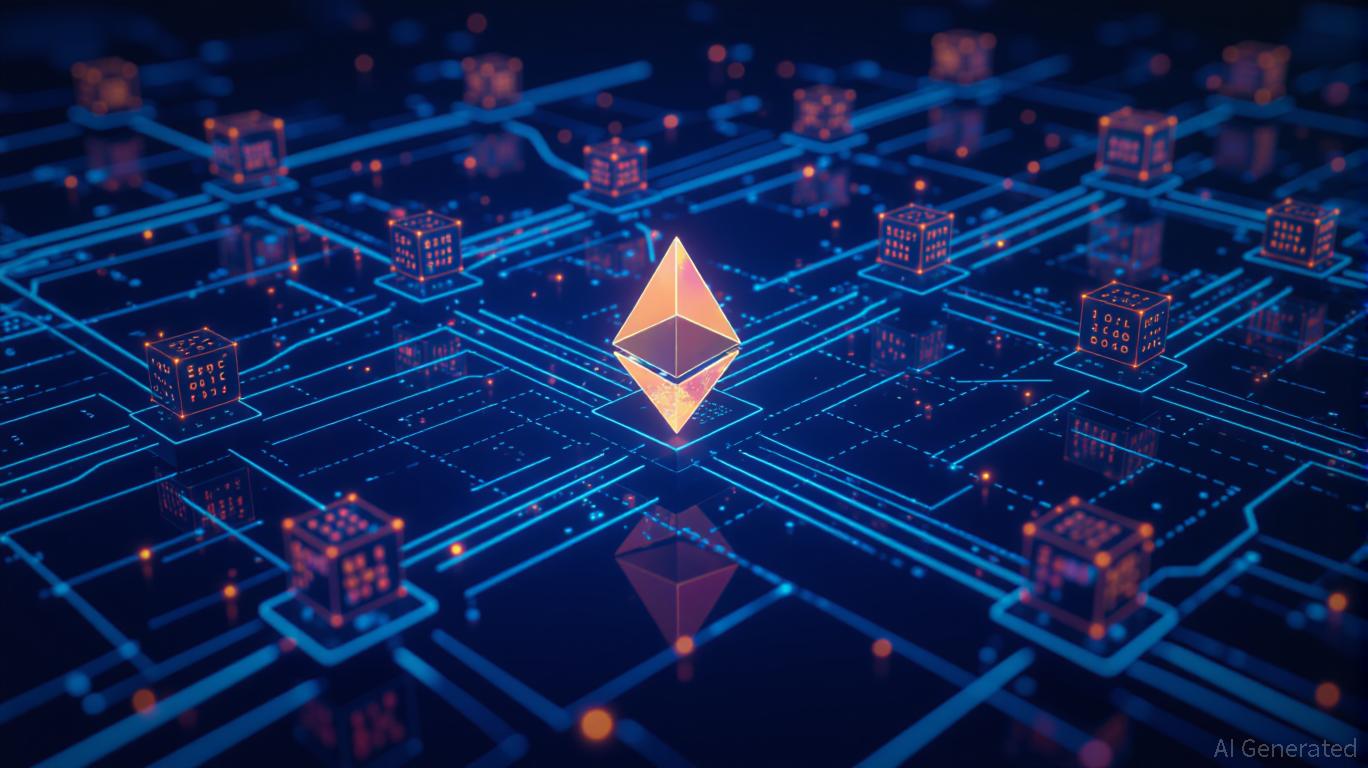AI Industry's Profit Boom Fails to Ease Doubts Over High Valuations Amid Intensifying Sell-Off
- AI sector faces valuation skepticism despite strong earnings, with Nasdaq down 2.2% as investors shift to defensive stocks. - C3.ai's 26% monthly decline highlights challenges: 19% revenue drop, leadership changes, and uncertain Microsoft partnership monetization. - Decentralized GPU platforms like CUDOS Intercloud gain traction by offering cost-effective alternatives to cloud giants through smart contracts. - Palantir contrasts with 62.8% revenue growth and 40.3% net margin, leveraging NVIDIA partnershi
AI Industry Faces Market Volatility Amid Valuation Doubts
The artificial intelligence industry experienced significant market swings recently, as investor concerns over lofty valuations overshadowed robust financial results from leading companies. This uncertainty sparked widespread selling across the sector.
Nvidia's Record Results Fail to Soothe Market Jitters
Nvidia Corp. (NVDA) posted an unprecedented $57 billion in third-quarter revenue, exceeding analyst forecasts and projecting $65 billion for the following quarter. Despite an initial surge, Nvidia’s stock ultimately closed down by 3.15%. The broader Nasdaq Composite Index also slipped 2.2%, with investors shifting funds into more defensive areas such as healthcare. This movement reflects growing doubts about the long-term sustainability of high AI stock valuations.
Advanced Micro Devices (AMD) was hit even harder, tumbling nearly 8%, highlighting the sector’s vulnerability. Market experts acknowledge the genuine impact of AI, but note that investors are now seeking more concrete proof of enduring commercial success before supporting current price levels.
C3.ai Under Pressure Despite Microsoft Partnership
C3.ai Inc. (AI) became a focal point for market unease, with its shares dropping over 5% in just five days and plunging 26% over the past month. The company has deepened its collaboration with Microsoft’s Azure cloud, integrating with tools like Copilot, Fabric, and Azure AI Foundry. However, C3.ai faces significant headwinds, including a 19% year-over-year revenue decline, leadership turnover, and ongoing acquisition rumors. CEO Stephen Ehikian has emphasized that the Microsoft alliance is intended to streamline AI adoption for enterprise clients, especially in government and defense.

Despite these efforts, persistent cash outflows and anticipated losses through 2028 have cast doubt on C3.ai’s long-term outlook.
Debate Over AI Infrastructure Scalability
The sector’s recent struggles have fueled a broader discussion about the scalability of AI infrastructure. While major cloud providers like Microsoft, AWS, and Google Cloud continue to dominate, decentralized alternatives such as CUDOS Intercloud are gaining momentum. These platforms offer affordable GPU resources through smart contracts and vetted data centers, appealing to independent developers and researchers who need flexible, cost-effective solutions without sacrificing performance. The rise of such decentralized models could signal a shift in the competitive landscape, challenging the dominance of traditional cloud giants.
Palantir Stands Out with Strong Growth and Profitability
In contrast, Palantir Technologies Inc. (PLTR) has charted a different course. The company reported $1.18 billion in third-quarter revenue, marking a 62.8% increase from the previous year, and expanded its partnership with NVIDIA to build an operational AI stack. Palantir’s impressive 40.3% net margin and $6.44 billion in cash reserves set it apart as a rare example of both rapid growth and financial discipline in the AI space, despite a forward price-to-earnings ratio of 228.5x.
With a Rule of 40 score of 114—an indicator that combines revenue growth and operating margins—Palantir outpaces competitors like Snowflake and C3.ai. Analysts argue that Palantir’s critical role in defense and enterprise AI markets supports its premium valuation.
Sector Splits Between Infrastructure Leaders and Software Specialists
The contrasting fortunes of companies like Palantir and C3.ai highlight a growing divide within the AI sector. Infrastructure providers are benefiting from the surge in demand for AI deployment, while software-focused firms are struggling to prove they can scale commercially. This divide is expected to widen as businesses increasingly seek solutions that integrate smoothly with existing cloud platforms.
Microsoft’s expanded partnership with C3.ai, which enables unified AI operations across Copilot, Fabric, and Azure AI Foundry, illustrates this trend. However, whether C3.ai can translate these collaborations into sustained revenue growth remains uncertain, especially as it faces fierce competition from major cloud providers.
Looking Ahead: Innovation, Profitability, and Adoption
As the AI industry navigates ongoing valuation pressures and operational hurdles, the evolving relationship between established cloud companies and emerging decentralized platforms will play a key role in shaping its future. For investors, the spotlight will remain on businesses that can deliver not only technological breakthroughs but also lasting profitability and clear routes to widespread enterprise adoption.
Disclaimer: The content of this article solely reflects the author's opinion and does not represent the platform in any capacity. This article is not intended to serve as a reference for making investment decisions.
You may also like
Bitcoin News Today: Bitcoin Faces a Pivotal Week: Optimistic Buying Meets Bearish Whales Amid Economic Uncertainty
- Bitcoin stabilizes near $87,000 after 11-day selloff, with analysts divided on whether the rebound signals a trend reversal or temporary relief. - US ETFs record $1.22B in outflows amid weak institutional demand, compounded by macroeconomic uncertainty and delayed Fed rate-cut expectations. - Technical indicators show mixed signals: RSI suggests waning bearish momentum, while a "Death Cross" pattern historically precedes deep corrections. - Institutional accumulation by mid-sized wallets contrasts with w

Dogecoin News Today: Dogecoin's ETF Ambitions Face Off Against Technical Downturn Amid Market Turbulence
- Dogecoin (DOGE) faces technical collapse after breaking below key support levels and moving averages, driven by 263% above-average volume and algorithmic selling. - Unexpected resilience emerges as DOGE rallies 2.6% post-Musk's D.O.G.E. initiative dissolution and gains 0.7% amid new spot ETF approvals like Grayscale's GDOG . - Broader crypto markets remain bearish with Bitcoin below $85,000 and $120B lost in 24 hours, while DOGE futures open interest surges 3.27% signaling speculative activity. - Analyst

AI’s Core Economic Transformation: Entrée Capital Allocates $300 Million to Advanced Technology
- Entrée Capital launches $300M fund targeting AI, deep-tech, and crypto, boosting total AUM to $1.5B. - Focus on vertical AI, quantum computing, and decentralized infrastructure to transform lagging sectors like manufacturing. - C3.ai deepens Microsoft partnership to integrate enterprise AI tools, enabling unified data operations on Azure. - C3.ai reports 21% YoY revenue growth ($87.2M Q1) as AI demand rises, but analysts warn of market immaturity risks. - Strategic bets on AI-driven innovation highlight
Evaluating the Lasting Investment Impact of Zero-Knowledge Scaling on Ethereum Ecosystems
- ZK-based Layer 2 market grows rapidly, with $28B TVL in 2025 and 60.7% CAGR projected to reach $90B by 2031. - ZKsync, StarkNet, and Polygon zkEVM lead by slashing fees and offering EVM compatibility, attracting institutional partnerships. - ZKsync's Atlas upgrade (15,000 TPS) and GKR protocol (43,000 TPS) highlight efficiency gains via Buterin's "kappa" metric. - Ethereum's Fusaka roadmap, including PeerDAS and Verkle Trees, aligns with ZK scaling goals, boosting STRK and ZK token valuations.
